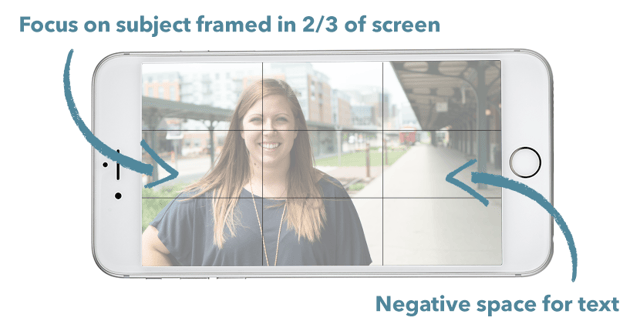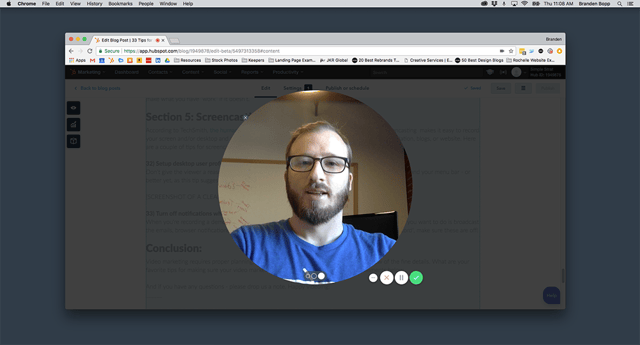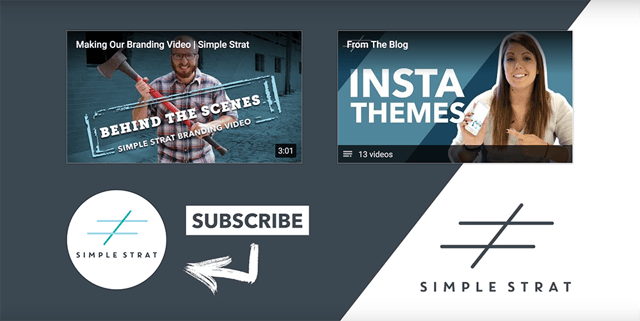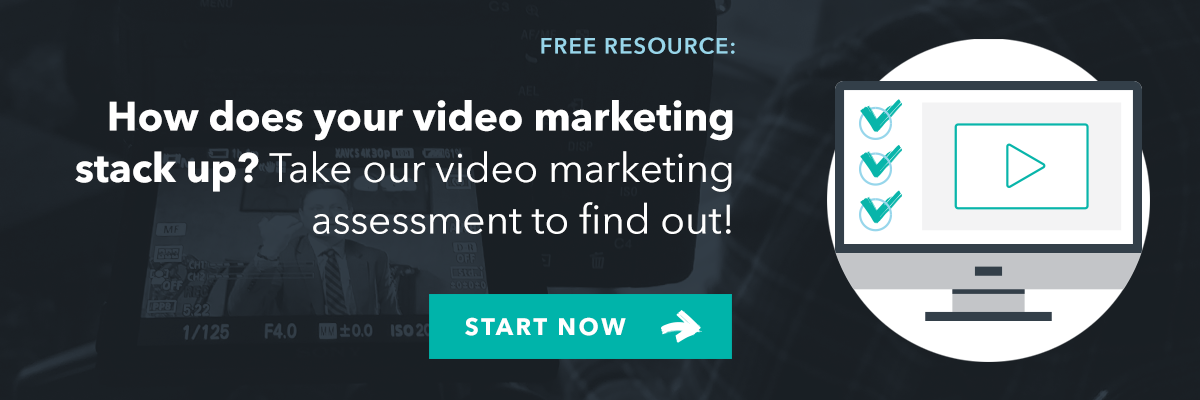Video marketing is on every marketer's to-do list for 2018. But how do you do it well?
Though video is a must-have medium, many companies still don't have a video resource in-house. But that's okay. The 33 video marketing tips in this article will help you produce better video for your company while learning a few things along the way.
These tips were originally presented at Inbound17, the world's largest inbound marketing conference held each year in Boston. This presentation was developed by Matthew Pierce, Learning and Video Ambassador at TechSmith, and originally contained 47 tips. We've whittled it down to 33 tips and added a bit more of our own insights based on the topics of many discussions with clients and potential clients in the last few months. Big thanks to Matthew for granting us permission to share his content and build off of it.
See the notes at the end of this article for additional information about TechSmith and their products.
33 Video Marketing Tips for Success
We've split the tips up into 7 sections so you can focus in on what aspect of video production you're working on.
- Section 1: Preparation
- Section 2: Audio
- Section 3: Shooting
- Section 4: Editing
- Section 5: Screencasting
Section 1: Preparation
1) Know the goal.
Marketers are good about knowing goals, or at least they should be! Know your goal and optimize your video for just that. This will affect the type of video you create, the length, content, distribution, level of production, resources needed, and more.
2) Plan it out.
It's amazing the number of people who just "jump into a video". Great video production that engages and educates requires a plan in advance. Planning will also save you time, money, and prevent issues in the editing phase. Make a good plan. Then DO it, and analyze and iterate when you're done.
3) Sketch out a workflow.
There are lots of things you “could do” - but knowing the flow in which you'll do them is important. This may look as simple as stating the goal, drafting the idea, storyboarding the concept, writing the script, shooting, editing, and promoting. The flow for your company may look different than someone else's, but the important thing is to have one.
4) Learn about your audience and design for them.
Know where your audience is going to watch or engage with your video content. Are they going to watch it on YouTube or on Facebook? For example, you have more flexbility with audio creativity on YouTube, but on Facebook, many users watch video content with the sound turned off. Design your video content so that your audience is able to engage in the environment they prefer.
5) Write a script to gain clarity, consistency, and conciseness.
Not every video requires a script - but it does require a list of talking points. Even if you're creating a screencast video (where you record your desktop while you speak) you should have a list of items you're going to cover and any important phrases you want to nail the first time. A script also helps prevent the habit of rambling on camera.
6) Create a storyboard.
This is where real time-savings come in. Know what you’ll say and where. What are the settings? What are the transitions? If you want to incorporate some "action footage" (B-roll) in your video, where will this come from? The storyboard will help you make the most of your time and resources.
7) Get feedback. Get critical feedback. Tear it apart.
If you’re not tearing it apart, you’re not getting better at it. Get feedback at the critical points of the process - the plan, the script, the storyboard, and the rough cut. Is this actually doing what you wanted it to from the goal and the plan?
8) Gather up assets before you start.
Excellent video production follows the same rules and guidelines that a print piece or other design asset would. You'll need to use the proper colors, logos, brand elements, etc. If you look at the videos on the Simple Strat YouTube Channel, you'll notice a consistency in the library - which makes it easy to recognize our brand from afar.
Section 2: Audio
According to Wisita, audio plays a major role in the way viewers experience your video. If people can't understand your message, it can lead to poor engagement and a negative overall experience.9) Record voiceovers first & match video to audio.
Audio is not as flexible as video. If you're planning on doing a video with action footage, photos, or images laid over an audio track, record the audio first and then adjust your footage and/or images to fit and illustrate the script.
10) Drink water.
This seems like a weak tip, right? Wrong. Having worked with voice actors in a number of professional level settings, we've realized that water makes a big difference in the clarity of the voice. So, drink up and stay hydrated!
11) Trust your voice.
Do you hate the sound of your own voice? Don't worry, it's not because you have a bad voice. In fact, you have a great voice! It just sounds different in your head than it does when you hear it on an audio or video recording. For some more insight into this, check out this article from Wistia. There are always things you can do to better enunciate and deliver your lines, but your voice is one of a kind! Learn to embrace it!
12) Use a good microphone - audio is 1/2 of the video.
Nothing ruins a video quicker than bad audio or poor lighting. So, let's make sure to get the audio right. If you're shooting with an iPhone, there are a number of smartphone mics on the market that can help you capture clearer audio. If you're using a digital SLR, refer to the owner's manual to identify external mics that are compatible with your device. If you're on your way to the pro level, you'll want to look at an external recorder and mic setup (if you're at that point, you could probably write this article!).
13) Check the mic & test audio levels.
Have you ever recorded a video only to find out the mic was muffled? Or not even picking up any audio? Always test prior to starting - this includes screencast videos and smartphone videos too. Too hot of a mic can distort a voice; set it too low and it's hard to hear. You can't fix bad audio in post - you can only make it less bad!
14) Select the right music.
Music is necessary for many videos, but you'll want to make sure to match the mood and tone. Keep the volume low and use it to compliment the content, not overpower it. Read up on royalty-free music as you'll want to use music that doesn't get you in trouble with the artist or leads your videos to be unusable on social media (Facebook and Instagram will often ban a video if it uses a copyrighted song).
Remember how we said if you record bad audio, you can only fix it to become less bad? The same goes for poor production. Get the lighting and shooting right, and the editing portion will go much easier.
15) Use rice paper to remove shine from talent.
You want your talent to look as good as possible on screen. You can use rice paper (order on amazon) to soak up the sweat that inevitably comes from being under lights (and being nervous sometimes!).
16) Hide wires and mics.
Mic cords can make a shoot look sloppy. You want the video to look as natural as possible. Bring some double sided tape to tape the lapel mic to the underside of a collar, and have the person on camera hide the wires under their clothes or jacket.
17) Use lights to remove shadows.
If you're going to be doing more than one video in your lifetime, it will benefit you to learn about 3-point lighting. It’s the most basic lighting setup there is. A well-lit set, even if shot on a smartphone, will do wonders for the production value of the video.
18) Rent gear when buying doesn’t make sense.
Not sure what type of camera you want to buy for your video production efforts? If you're ready to take it a notch above the smartphone producer, then you may want to consider renting first. At Simple Strat, we love lensrentals.com as we often rent specific lenses for shoots that we don't do everyday. Your local camera/video store may also be able to help.

19) Start rolling before you're ready.
Have you ever heard of camera-face? It's that face that people suddenly get when they realize the camera is on. We're all susceptible to getting it - which is why you should start rolling before you're ready. Once on-camera talent subtly forgets the camera is there, they're comfortable to be more like themselves and forego the awful camera face disease!
20) Capture B-roll.
In film and television production, B-roll, B roll, B-reel or B reel is supplemental or alternative footage intercut with the main shot. (The term A-roll referring to the main footage has fallen out of usage). B-roll is basically anything that’s not your main footage. B-roll is often what gives a video it's interesting value. At Simple Strat, we capture a lot of B-roll for behind the scenes content, footage to illustrate our company culture, and more. Intentional B-roll is captured when illustrating something someone said on camera. Without B-roll, you may have 60 seconds of a "talking head" - which is far less interesting and more likely to have someone click away sooner.
21) Avoid digital zoom.
If you're shooting on a smartphone, you'll want to avoid using the digital zoom. While some smartphones are handling this better, anytime you pinch, you distort the image and make it blurry and pixelated. If you're interviewing someone, simply get in closer.
22) Use a tripod.
Regardless of how steady you think you are, your hands cannot replace the steadiness of a good tripod. There are a number of table top tripods and smartphone holders on the market. If you're utilizing a digital SLR, you'll want something strong and supportive. Check out our post about cheap video equipment to get you started.
27) Use the rule of thirds - don't always center.
Especially when doing video interviews, learn about the rule of thirds. The rule of thirds is applied by aligning a subject with the guide lines and their intersection points, placing the horizon on the top or bottom line, or allowing linear features in the image to flow from section to section. Centering is still an option, but it's often used for a specific purpose such as a video where you're changing out people from the screen quickly.

Did you know that a film takes, on average, two years to produce - and only about 6-8 weeks of that is actual shooting? The magic (and the motherload of the work!) happens in the editing process.
28) Keep clips short so that things keep moving.
When you're editing a video, you want things to change. If you watch television, watch for how often it changes from shot to shot. It's important to keep the viewer engaged. Make sure that things are moving with a purpose though, or you run the risk of the video seeming choppy and distruptive.
29) Add transitions. Keep the star wipe at home.
Just because you can doesn't mean you should - that goes for the number of video transitions available in any basic editing software. Transitions should help carry the viewer from one shot to the next. If you're going to use wacky transitions, use them with purpose and intentionality.
30) When needed, use annotations and text to add interest and draw attention.
How can you enhance your video? Since we watch many of our videos online without turning on the sound, annotations and text can help illustrate the video and draw the the viewer into the content - actually enticing them to turn on the sound for the whole experience. Be careful though, too much can overwhelm the viewer. Use blocks of text sparingly. You can’t watch and read at the same time very well.
31) Always start with a rough cut
The editing process is a journey - it's never going to be perfect on the first try, so leverage that first rough cut as an opporutnity to revisit your goals and how the video is or is not achieving them. If you need to capture some more footage, do it - don't try to make what you have "work" if it doesn't.
According to TechSmith, the human brain processes visuals 60,000 times faster than text. Screencasting makes it easy to record your screen and/or desktop and add videos and images to your email, training materials, documentation, blogs, or website. Here are a couple of tips for screencasting success.
32) Set up desktop user profile that’s clean and ready to record.
Don't give the viewer a reason to be distracted from the main content at hand. Clear off your desktop and your menu bar - or better yet, as this tip suggests, create a desktop user profile that you can use each time you screencast.

33) Turn off notifications when recording
When you're recording a demo of your software or a how-to video for your customers, the last thing you want to do is broadcast the emails, browser notifications, or dropbox updates you're getting each minute. Before you hit "record", make sure these are off!
Conclusion:
Video marketing requires proper planning, attention to audio and composition, and a review of the fine details. If you're just getting started with video marketing, check out our full video marketing guide to learn even more about putting these tips into action. What are your favorite tips for making sure your video marketing is a success? Let us know in the comments below.
And if you have any questions - please drop us a note. Happy videoing!
______
Founded in 1987, TechSmith pioneered the revolutionary idea of capturing screen content for better communication. Today, TechSmith is the world’s #1 source for visual communication software. They are the company behind some of the industry's leading technology, including Camtastia (video editor), SnagIt (screen capture), and Screencast (content organizer).
Learn more about TechSmith at their website: www.techsmith.com.
Connect with Matthew Pierce on LinkedIn: https://www.linkedin.com/in/matthewrpierce/
Connect with Matthew Pierce on LinkedIn: https://www.linkedin.com/in/matthewrpierce/







